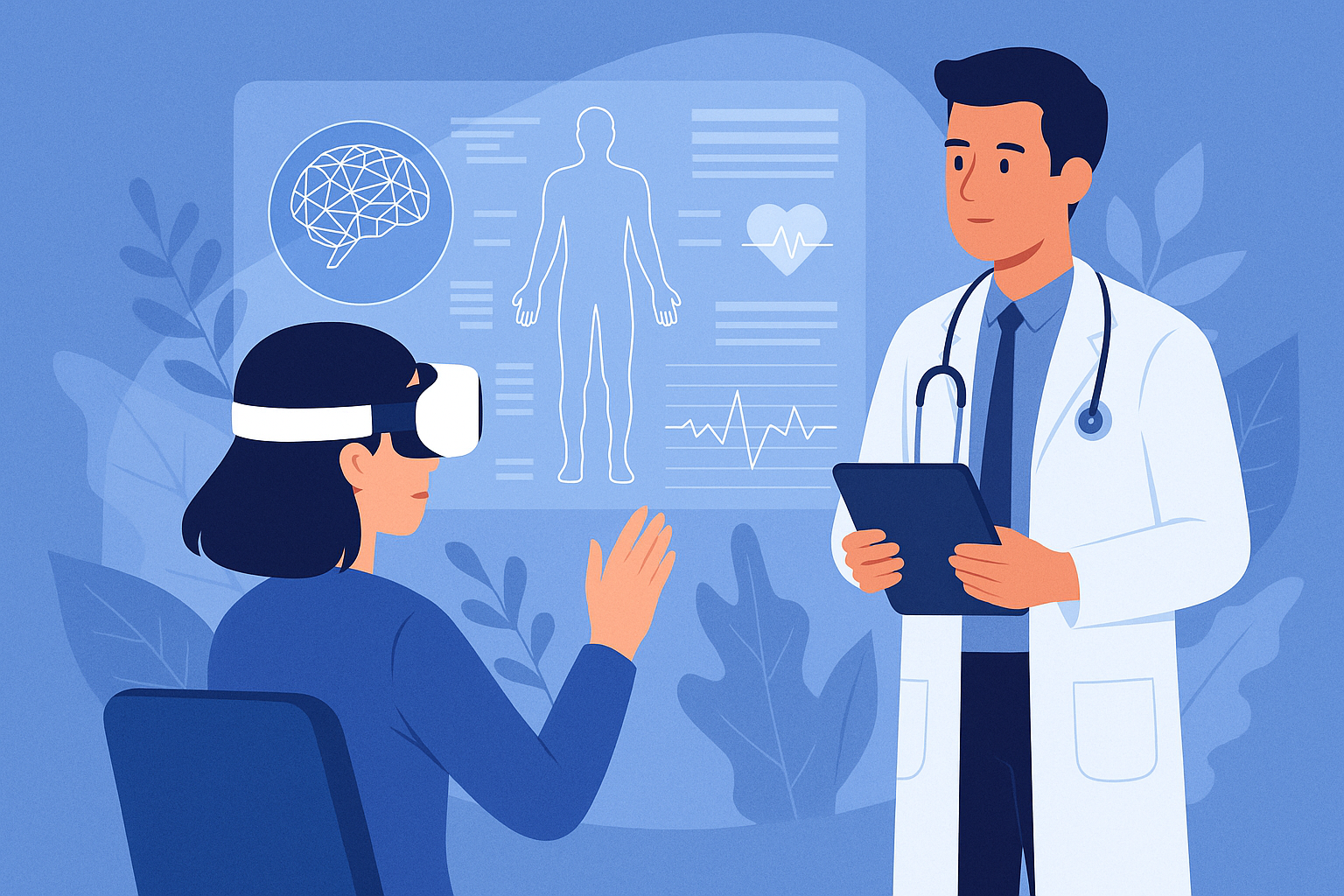How VR Healthcare Companies Are Shaping the Future of Medicine

The healthcare industry is entering a new era — one where healing isn’t confined to hospital walls, and therapy doesn’t always require a physical presence. At the heart of this transformation is virtual reality (VR) ,a powerful tool that is redefining how we treat, rehabilitate, and support the human body and mind.
VR healthcare companies are emerging as vital players in this revolution. These companies develop immersive VR-based solutions that not only support traditional healthcare methods but often improve upon them. From physical rehabilitation to mental health therapy, VR is enhancing outcomes, increasing access, and transforming the patient experience.
What Is a VR Healthcare Company?
A VR healthcare company combines expertise in healthcare, psychology, rehabilitation, and immersive technology to build virtual environments that can simulate real-world scenarios, guide physical movements, regulate mental states, or train medical professionals.
These companies operate at the intersection of innovation and empathy — creating solutions that don’t just digitize care but reimagine it.
For example, CogniHab, a health-tech company based in India, develops VR platforms focused on rehabilitation, rejuvenation, and relaxation. Their suite of solutions addresses conditions like stroke recovery, spinal cord injuries, amblyopia (lazy eye), cerebral palsy, autism spectrum disorders, and anxiety. It’s a complete ecosystem that promotes healing through immersive, interactive experiences that feel real — but take place entirely in virtual spaces.
How VR Is Used in Healthcare: Major Applications
1. Physical Rehabilitation and Motor Recovery
Traditional rehab can often feel repetitive, slow, and demotivating. With VR, therapy becomes interactive and engaging, encouraging patients to stay consistent and push their limits in a safe, gamified environment.
VR rehabilitation modules can simulate real-world activities like:
-
Brushing teeth
-
Lifting objects
-
Turning on a light switch
-
Placing rings on rods
-
Eating with utensils
Patients recovering from stroke or spinal cord injuries can perform these actions inside virtual environments with guided support, enabling motor skill recovery, hand-eye coordination, and muscle reactivation.
CogniHab’s Upper Body Rehabilitation Suite helps patients perform day-to-day internal and external tasks — all within a controlled, repeatable environment.
2. Anxiety and Stress Reduction
Anxiety disorders are among the most common mental health issues worldwide. Yet, access to therapy remains limited in many regions. VR provides a bridge.
Through calming, immersive experiences — such as walking through forests, meditating underwater, or floating in space — patients are able to experience instant grounding, reduce overthinking, and ease their nervous system.
Unlike traditional meditation apps, VR fully removes visual distractions by immersing the user in 360-degree environments. This helps people disconnect from overwhelming surroundings and reconnect with their breath, body, and focus.
Experience mindful clarity with CogniHab’s immersive VR meditation journeys.
3. Mental Health and Cognitive Behavioral Therapy (CBT)
VR is increasingly being used to treat PTSD, depression, and phobias through exposure therapy and cognitive interventions. By recreating anxiety-inducing environments in a controlled way, therapists can gradually help patients desensitize and regain confidence.
Some VR healthcare companies are also integrating AI-based CBT chatbots into their platforms, enabling patients to receive personalized therapy experiences in real time.
This technology doesn’t replace human care, but it complements it, especially in areas where access to mental health professionals is scarce or costly.
4. Vision Therapy and Neuroplasticity
Children with amblyopia (lazy eye) or individuals with vision coordination issues can benefit from interactive visual exercises in VR. Unlike traditional patching, which can be frustrating for children, VR-based therapy can offer stimulating, game-like environments where both eyes are engaged and trained simultaneously.
Similarly, for children with autism or adults with mild cognitive impairment, VR scenarios help simulate real-life social interactions, emotional recognition tasks, and daily life activities — supporting cognitive and behavioral development.
5. Medical Education and Training
VR isn’t just for patients. Medical professionals can now practice surgeries, diagnose virtual patients, and learn anatomy in fully immersive 3D environments. This has drastically reduced learning curves and enhanced retention of complex concepts.
Imagine a medical student walking through a beating human heart in VR, observing valves, blood flow, and malfunctions in real time — without needing cadavers or labs.
VR training is risk-free, cost-effective, and scalable — especially important in low-resource settings where hands-on training is limited.
Benefits of VR Healthcare Solutions
VR offers a multitude of benefits that go beyond convenience:
-
🔁 Repeatable: Simulations and therapy exercises can be repeated endlessly without risk of injury or patient fatigue.
-
🎯 Personalized: Therapies can be adapted based on progress, mobility, age, and cognitive function.
-
📊 Data-Driven: Most VR systems offer real-time analytics, helping therapists track engagement, accuracy, duration, and improvement.
-
🌍 Accessible: VR makes care more inclusive for rural areas, elderly populations, or mobility-restricted patients.
-
🧠 Dual Benefit: Simultaneously supports mental and physical recovery, making it ideal for holistic health programs.
How Companies Like CogniHab Are Leading the Way
CogniHab is an example of how VR healthcare companies are aligning medical expertise with immersive technology. Their VR suite doesn’t just include generic mindfulness content — it’s built to serve real clinical needs, from rehabilitation tasks to mental wellness journeys and vision therapy.
What sets companies like CogniHab apart is their commitment to scientific grounding. Every experience is designed in consultation with doctors, therapists, and behavioral experts — ensuring that it’s not just immersive, but also clinically meaningful.
And most importantly, they’re making these solutions affordable and scalable — helping hospitals, clinics, and even remote care centers expand their services using just a VR headset and a software license.
The Future of VR in Healthcare
As technology evolves, the potential of VR in medicine will only grow. Future VR healthcare platforms may include:
-
AI-driven therapy assistants
-
Emotion-sensing environments
-
Remote consultations in virtual clinics
-
Customized neurofeedback for mental health
-
VR mindfulness rooms in workplaces and hospitals
What once seemed futuristic is now increasingly practical — and urgent. With rising mental health challenges, aging populations, and demand for remote care, VR offers not just a new way to deliver healthcare — but a smarter, more compassionate one.
Read more health related Articles:- https://theglobalnewz.com/category/health/
Final Thoughts
VR healthcare companies are redefining what it means to heal. They’re giving patients the power to recover at their own pace, in spaces that feel safe, engaging, and personalized. They’re helping therapists go beyond the clinic. And they’re creating new standards for what care can look like in the digital age.
If you’re a hospital administrator, clinic owner, or wellness provider looking to bring next-gen care to your patients, contact us now to explore what VR healthcare companies like CogniHab can offer.
Because the future of medicine isn’t just about treating the body , it’s about caring for the whole person, one immersive experience at a time.


